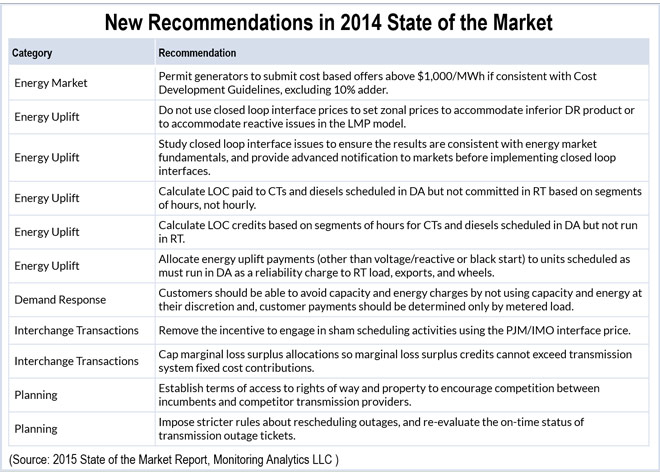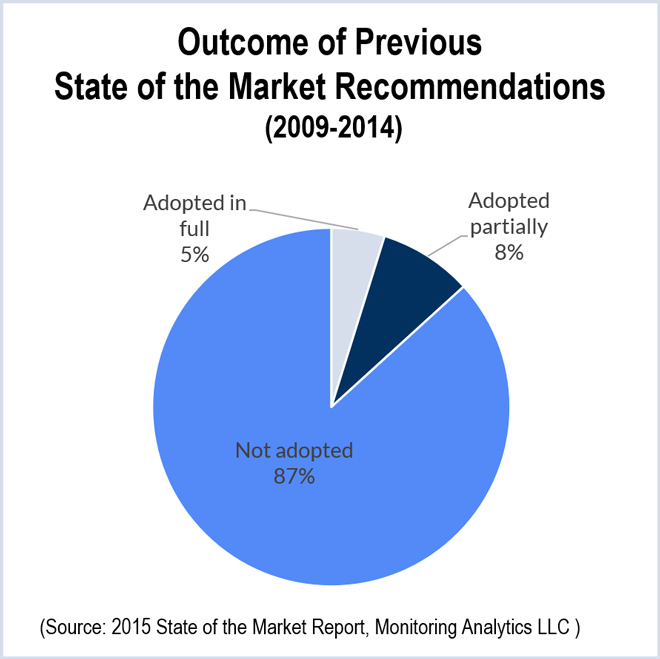By Rich Heidorn Jr.
PJM’s markets were generally competitive in 2014, but last winter’s cold resulted in a 37% increase in LMPs and raised concerns about economic withholding, the Independent Market Monitor said in its annual State of the Market report, released Thursday.
Market Monitor Joe Bowring said weather-related demand and higher fuel costs in the first quarter boosted energy prices for 2014 despite lower prices the rest of the year.
Real-time LMPs rose from $38.66/MWh in 2013 to $53.14/MWh last year. Congestion costs increased by $1.2 billion (186%), and uplift jumped 11% to a record $965 million.
As a result, total billings increased by 62% to a record $50 billion, beating the previous record of $35.6 billion set in 2011.
The Monitor said the results show energy prices were generally competitive, meaning they were set by generators offering at, or close to, their marginal costs. The exception was the high demand hours in January 2014, when the behavior of some participants raised concerns about “economic withholding.”
“In particular, there are issues related to the ability to increase markups substantially in tight market conditions, to the uncertainties about the pricing and availability of natural gas, and to the lack of adequate incentives for unit owners to take all necessary actions to acquire fuel and generate power rather than take an outage,” the report said. “One of the symptoms of these issues was an unprecedented increase in uplift charges in January.”
The adjusted markup component of LMP doubled from $1.16/MWh (3%) to $3.32/MWh (6.2%).
“There are currently no market power mitigation rules in place that limit the ability to exercise market power when aggregate market conditions are extremely tight,” the Monitor said. “If market-based offer caps are raised, aggregate market power mitigation rules need to be developed.”
The report includes 11 new recommendations (see table above). Only four of the Monitor’s 83 previous recommendations between 2009 and 2014 have been adopted in full, with another seven adopted in part. The remainder (87%) have not been acted on.
Generator Revenues
Thanks to the high prices last winter, average net revenues — a measure of the incentive to invest in new generation — rose sharply for many generators, with an increase of 74% for combustion turbines, 30% percent for combined-cycle plants, 113% for coal, 43% for nuclear, 24% for wind and 7% for solar.
“The impact of a relatively short period of high loads on net revenues illustrates how scarcity pricing can work to address the missing money issue in wholesale power markets,” the report said.
A new combined-cycle plant would have been profitable in 12 of 19 zones in 2014, while a new CT would have been profitable in 10 eastern zones. Despite the increases, however, new coal and nuclear plants would not have been profitable anywhere in PJM last year.
“Coal is still not remotely close to a signal to invest,” Bowring said during a press briefing last week.
The report identified 22 generators totaling almost 7,000 MW as at risk of retirement, 70% of the capacity from coal units with an average age of 46 years. One-quarter of the at-risk capacity are oil- or gas-fired steam units with an average vintage of 35 years.
Falling into this category were units that did not recover avoidable costs from total market revenues or did not clear the 2016/17 or 2017/18 base residual auctions but cleared in previous capacity auctions.
This is in addition to almost 27,000 MW of retirements that occurred or are expected between 2011 and 2019.
Capacity Market
Bowring also continued his campaign against the inclusion of limited demand response in the capacity market. DR and the 2.5% “holdback” to demand reduced capacity revenues by $3.4 billion (31%), Bowring said.
Total payments for DR rose almost 44% to $676 million in 2014 thanks largely to a $195 million increase in capacity revenues.
The Monitor said DR should be used to offset demand rather than treated as supply.
“A successful redesign of the PJM capacity market to address its identified flaws is the most critical initiative currently being considered by PJM stakeholders,” the report said. PJM’s Capacity Performance proposal, which would address some of the Monitor’s concerns, is pending before the Federal Energy Regulatory Commission.
Auction Revenue Rights & Financial Transmission Rights
Auction revenue rights and financial transmission rights revenues offset almost 91% of total congestion costs in the day-ahead energy market and the balancing energy market for the first seven months of the 2014/15 planning period, nearing full funding “for the first time in quite some time,” Bowring said.
The improvement resulted from a reduction in ARR allocations. “We don’t think it should have been done that way,” Bowring said. “And we think the underlying problems with FTR funding remain.”
The report cites a market design that it said “incorporates widespread cross subsidies.”
Uplift
Uplift rose $96 million to almost $965 million, although uplift as a share of total billings fell to 1.9% from 2.6%. Balancing charges increased $407 million, partially offset by a $282 million reduction in reactive services.
The recipients of uplift payments remained “remarkably concentrated,” Bowring said, with 10 units responsible for more than one-third of the total.
Bowring repeated his call for a change in confidentiality rules that would allow him to identify the units so that competitors could propose new generation or transmission to address the need for the out-of-market payments.
The lack of transparency “means there’s no competitive pressure on them,” Bowring said. “It’s not possible to compete that away.”




